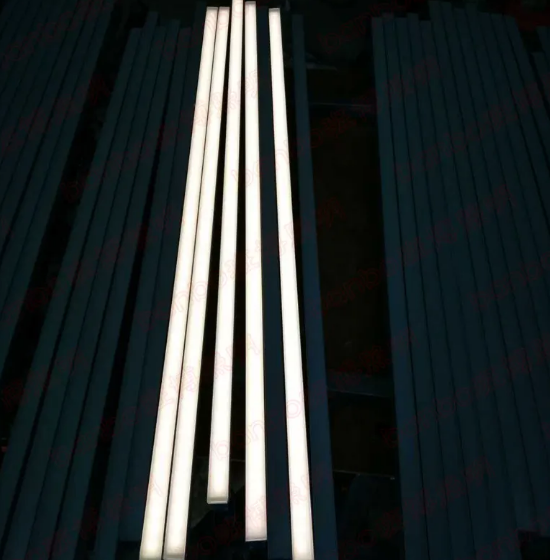Basic Knowledge of LED
1, LED luminous principle
LED (Light Emitting Diode) is short for light-emitting diode. Diodes made from compounds of gallium (Ga), arsenic (AS) and phosphorus (P) radiate visible light when electrons are combined with holes, and can therefore be used to make light-emitting diodes, which can be used as indicators in circuits and instruments, or as text or digital displays. Gallium phosphorus arsenide diodes emit red light, gallium phosphide diodes emit green light, and silicon carbide diodes emit yellow light.
With the progress of science and technology, the appearance of pixel led strip can emit similar incandescent light color, which provides a lighting source with prolonged life and elevated efficiency for modern lighting. The most valuable is that LED devices have a life of more than 50,000 to 100,000 hours, suitable for a variety of applications.
2. Characteristics of LED
The light emitted by LED is different from natural light because its spectrum is not continuous and lacks infrared part. Therefore, unlike incandescent lamps, the heat generated by LED is not emitted by radiation but must be emitted by conduction, which is also the reason why LED is called cold light source.
LED has the following advantages:
Extreme efficiency and energy saving: White LED is the most energy saving white light source device known at present. Only a few kilowatt-hours of electricity consumption (ordinary 60W incandescent lamp consumes 1 kilowatt-hours of electricity for 17 hours, ordinary 10W energy-saving lamp consumes 1 kilowatt-hours of electricity for 100 hours)
Super high life: semiconductor chip light, no filament, no glass bubble, not afraid of vibration, not easy to break, the service life can reach more than 50,000 hours (ordinary incandescent lamp service life is only hundreds of hours, ordinary energy-saving lamp service life is only 8,000 hours)

Green and environmental protection: free of harmful elements such as mercury and xenon, conducive to recycling and utilization, and will not cause electromagnetic interference (common light tubes contain elements such as mercury and lead, and the electronic ballast in energy-saving lamps will cause electromagnetic interference, and there are also mercury elements in the tube)
Vision protection: DC drive, no stroboscopic (ordinary lights are AC driven, it is bound to produce stroboscopic)
Extreme light efficiency: low heat: 90% of the electric energy is converted to visible light (80% of the electric energy of ordinary incandescent lamp is converted to heat energy, and only 20% is converted to light energy)
Large market potential: low voltage, DC power supply, battery, solar power supply can be used for remote mountainous areas and field lighting and other lack of electricity, less electricity places.
According to the prediction of the international authority, semiconductor light-emitting diode lighting will replace the existing traditional light source in the next 5-10 years. Of course, this will depend on the white LED cheaper, scientific and technological progress will inevitably lead to the rapid growth of the overall capacity of the market. Technicians have measured that leds use only one-tenth as much power as incandescent bulbs at the same brightness and last 100 times longer. Due to the advantages of energy saving, environmental protection, long life and tiny size of LED, experts call it another leap in the history of human lighting after incandescent and fluorescent lamps. According to the U.S. Department of Energy, the complete replacement of traditional lighting will begin in 2010. Japan, the United States, Europe, South Korea and other countries have officially launched the LED lighting strategic plan. It is reported that the pavilions of numerous developed countries at this year's World Expo in Shanghai have completely used LED as lighting sources. In our country, the application of LED is also in the development stage, but because our country does not master the core technology of high-power LED, the domestic is still in the import of semiconductor chips, domestic packaging stage, thus from the price compared to foreign countries is still at the high level, the application is also slightly affected.
3. Electrical characteristics of LED light-emitting diodes
When the voltage value is reached, the LED will start to emit light. When the voltage is increased, the luminance of the LED will increase sharply. If the voltage is increased slightly, the LED may be burned instantaneously. This is the main reason why LED devices are inconsistent with other light sources in use, and it is also a key factor for the safe use of LED, which requires full attention of designers.
The figure above shows the relationship between the forward drive current and the output brightness of the LED chip with the power of 1W. It can be seen that the drive current and the lumen output show an obvious linear relationship within the range of 350mA. However, with the increase of the forward current, the nonlinear relationship between the two gradually appears. When the drive current exceeds the linear range, the efficiency of the lumens generated per watt will decrease, while in the linear range, the number of lumens generated per watt will show an upward trend. When the driving current exceeds the linear range, the output power will be converted from LED to heat energy. This heat energy will become the burden of LED driver, increase the complexity of thermal design, and reduce the life of LED. Therefore, for LED devices with 1W power, the forward drive current does not exceed 350mA. With the diameter of 5 tiny power LED lamp beads in common use, the forward current is not more than 20mA. For 3W high-power LED chips, the forward current should not exceed 700mA.